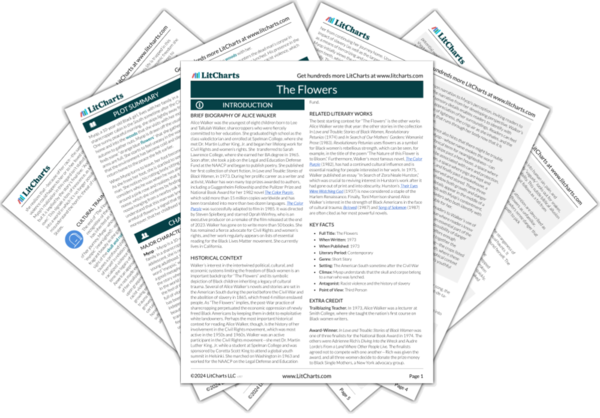Published in 1973, five years after the assassination of Martin Luther King, Jr., “The Flowers” illustrates how the racial injustices of slavery continued long after the Civil War. Although “The Flowers” does not specify its setting, its reference to Myop’s home as a “sharecropper cabin” reveals that it is set after the Civil War, and its reference to harvesting peanuts and cotton suggests it is in the South (where these crops grow). Sharecropping, sometimes called “slavery by another name,” continued the exploitation and economic oppression of Black people after slavery was abolished by keeping them permanently indebted to white landowners, who charged sharecroppers exorbitant rates to operate farms on their land. This system of racial and economic injustice kept Black Americans tied to the land and made it nearly impossible to gain economic independence.
Living on a sharecropper farm, Myop’s life is trapped in this cycle of injustice, which robs her of the economic freedom she might enjoy in a truly free country. These references to sharecropping and crops associated with the South are important because they conjure the history of slavery in America. However, the absence of a more specific time and place also contribute to the story by suggesting that Myop’s experience may not be part of a distant past—it’s still possible, in other words, to come upon the remnants of racist violence in contemporary times. For example, the mere imagery of a noose looms large in the contemporary American imagination as an alarming reminder of the country’s history of racist violence and the unfortunate ways in which this history has continued to resonate in the present.
Racism, History, and Economic Injustice ThemeTracker

Racism, History, and Economic Injustice Quotes in The Flowers
Myop gazed around the spot with interest. Very near where she’d stepped into the head was a wild pink rose. As she picked it to add to her bundle she noticed a raised mound, a ring, around the rose’s root. It was the rotted remains of a noose, a bit of shredding plowline, now blending benignly into the soil. Around an overhanging limb of a great spreading oak clung another piece. Frayed, rotted, bleached, and frazzled—barely there—but spinning restlessly in the breeze. Myop laid down her flowers.
And the summer was over.

Unlock explanations and citation info for this and every other The Flowers quote.
Plus so much more...
Get LitCharts A+








